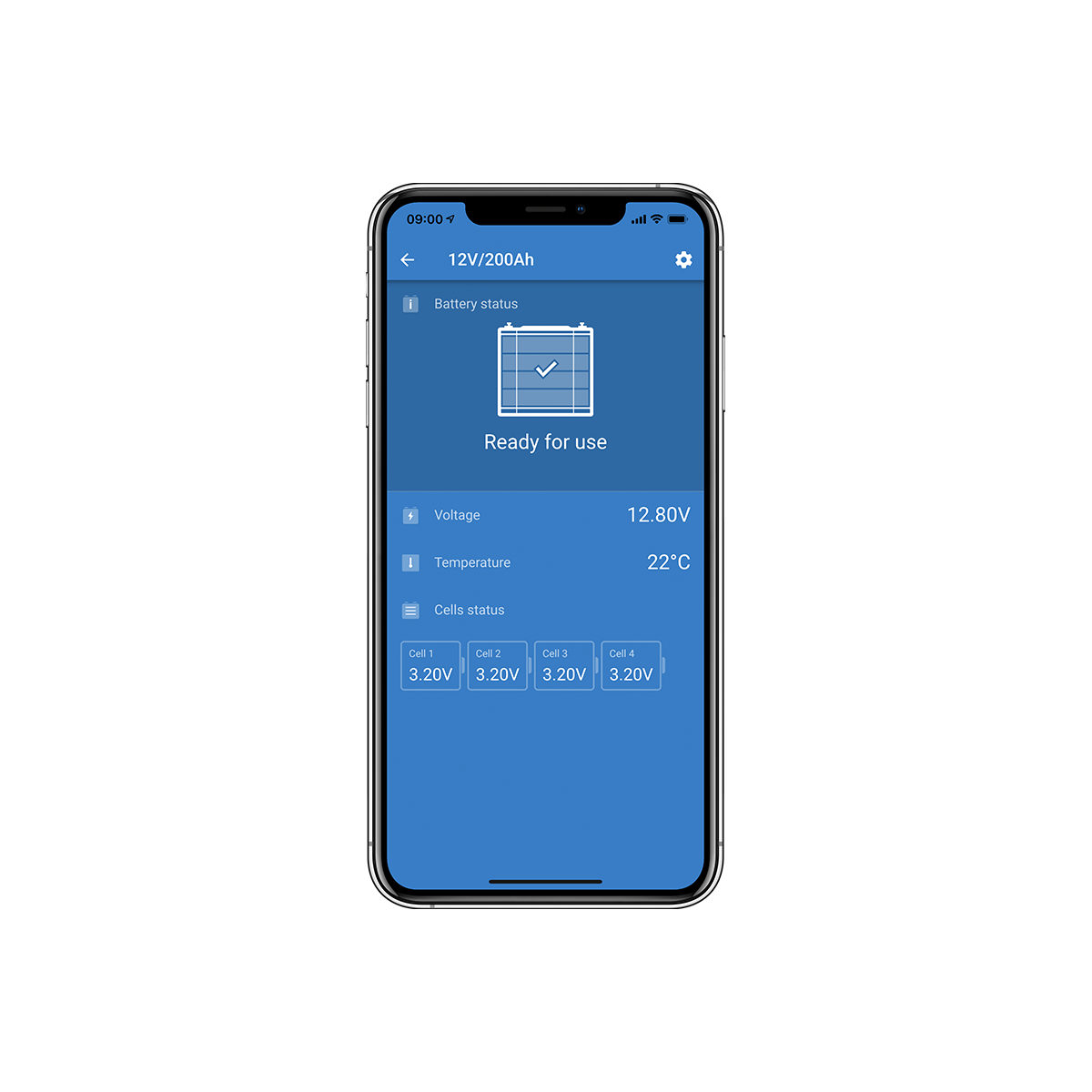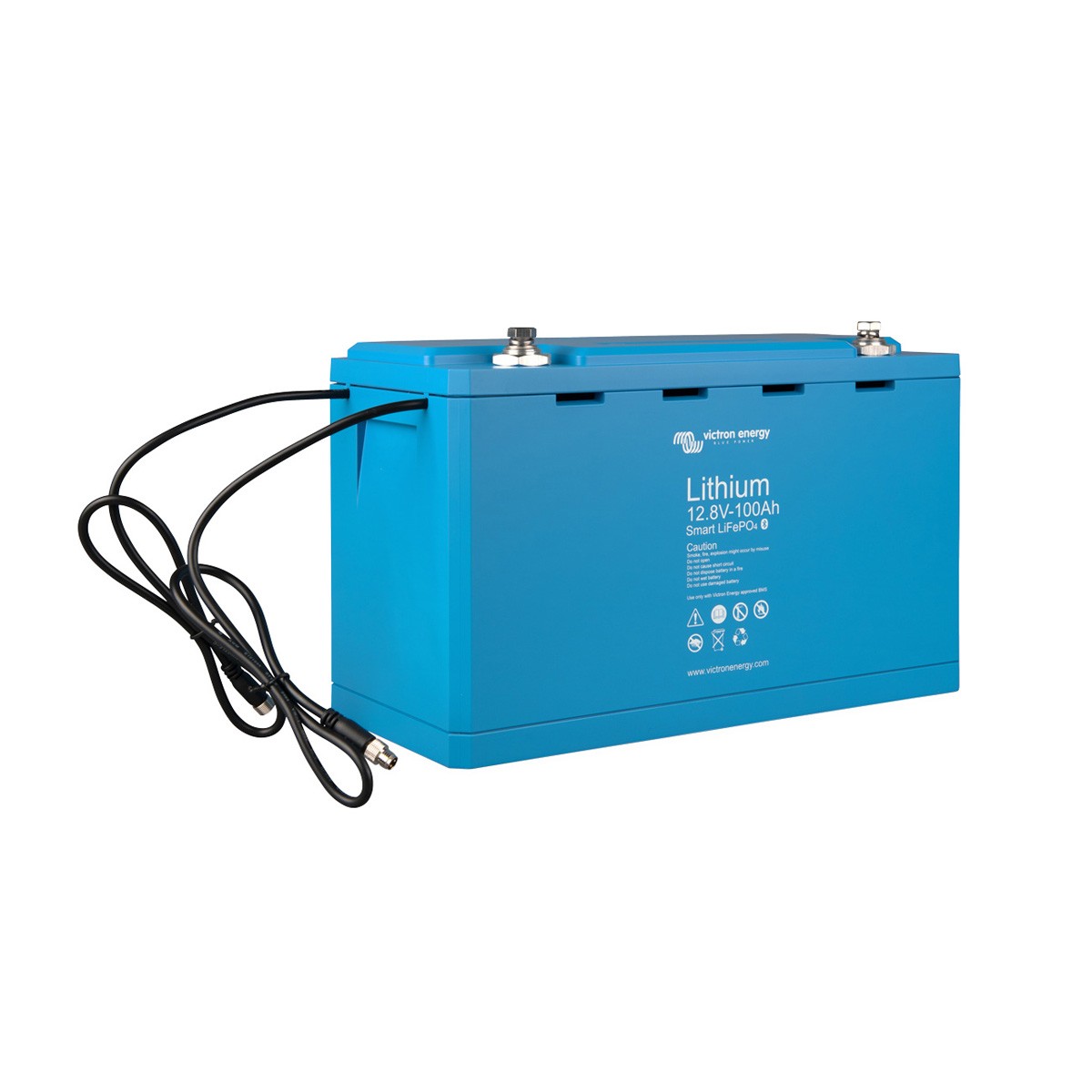Batteries
Smart LiFePO4 12.8 V/100 Ah Victron Energy lithium battery
Manufacturer: Victron Energy
INDEX: BAT512110610
Lithium-iron-phosphate (LiFePO4 or LFP) is the safest of the mainstream li-ion battery types. The nominal voltage of a LFP cell is 3,2 V (lead-acid: 2V/cell). A 12,8 V LFP battery therefore consists of 4 cells connected in series; and a 25,6 V battery consists of 8 cells connected in series.
Features that distinguish the product:
 Integrated cell balancing
Integrated cell balancing Can be parallel and series connected
Can be parallel and series connected Bluetooth app available to monitor cell voltage and temperature
Bluetooth app available to monitor cell voltage and temperature The round-trip energy efficiency of a LFP battery is 92%
The round-trip energy efficiency of a LFP battery is 92% Flexible charging voltage level
Flexible charging voltage level
Rugged
- A lead-acid battery will fail prematurely due to sulfation:
 If it operates in deficit mode during long periods of time (i.e. if the battery is rarely, or never at all, fully charged)
If it operates in deficit mode during long periods of time (i.e. if the battery is rarely, or never at all, fully charged) If it is left partially charged or worse, fully discharged (yacht or mobile home during wintertime)
If it is left partially charged or worse, fully discharged (yacht or mobile home during wintertime)
A LiFePO4 battery does not need to be fully charged. Service life even slightly improves in case of partial charge instead of a full charge. This is a major advantage of LFP compared to lead-acid.Other advantages are the wide operating temperature range, excellent cycling performance, low internal resistance and high efficiency (see below).LFP is therefore the chemistry of choice for demanding applications.
Efficient
In several applications (especially off-grid solar and/or wind), energy efficiency can be of crucial importance. The round-trip energy efficiency (discharge from 100% to 0% and back to 100% charged) of the average lead-acid battery is 80%. The round-trip energy efficiency of a LFP battery is 92%.
The charge process of lead-acid batteries becomes particularly inefficient when the 80% state of charge has been reached, resulting in efficiencies of 50% or even less in solar systems where several days of reserve energy is required (battery operating in 70% to 100% charged state).In contrast, a LFP battery will still achieve 90% efficiency under shallow discharge conditions.
Size and weight
- Saves up to 70% in space
- Saves up to 70% in weight
Endless flexibility
A LiFePO4 batteries are easier to charge than lead-acid batteries. The charge voltage may vary from 14 V to 15 V resp. 28 V to 30 V (as long as no cell is subjected to more than 4,2 V), and they do not need to be fully charged. Therefore several batteries can be connected in parallel and no damage will occur if some batteries are less charged than others.
Monitoring
With Bluetooth cell voltages, temperature and alarm status can be monitored.Very useful to localize a (potential) problem, such as cell imbalance.
Requires one of these BMS-es:
 VE.Bus BMS – recommended for systems with our inverter/chargers
VE.Bus BMS – recommended for systems with our inverter/chargers smallBMS – recommend for use in small systems
smallBMS – recommend for use in small systems Battery Management System BMS 12/200 – recommend for use in Automotive and Marine systems having DC-loads and Alternators
Battery Management System BMS 12/200 – recommend for use in Automotive and Marine systems having DC-loads and Alternators Smart BMS CL 12/100 – recommended for use in Automotive and Marine systems having DC-loads and Alternators
Smart BMS CL 12/100 – recommended for use in Automotive and Marine systems having DC-loads and Alternators
| Battery technology: | Lithium-ion |
|---|---|
| Communication type: | Bluetooth |
| Weight [kg]: | 14.01 |
| Dimensions [mm]: | 197.0 x 321.0 x 152.0 |
| Nominal battery voltage [V]: | 12,8 |
|---|---|
| Nominal capacity at -20 oC [Ah]: | 50 |
| Nominal capacity at 0 oC [Ah]: | 80 |
| Nominal capacity at 25 oC [Ah]: | 100 |
| Recommended charge current [A]: | 50 |
| Recommended continuous discharge current [A]: | 100 |
| Usable capacity [kWh]: | 1.28 |
| Maximum charge current [A]: | 200 |
| Maximum continuous discharge current [A]: | 200 |








